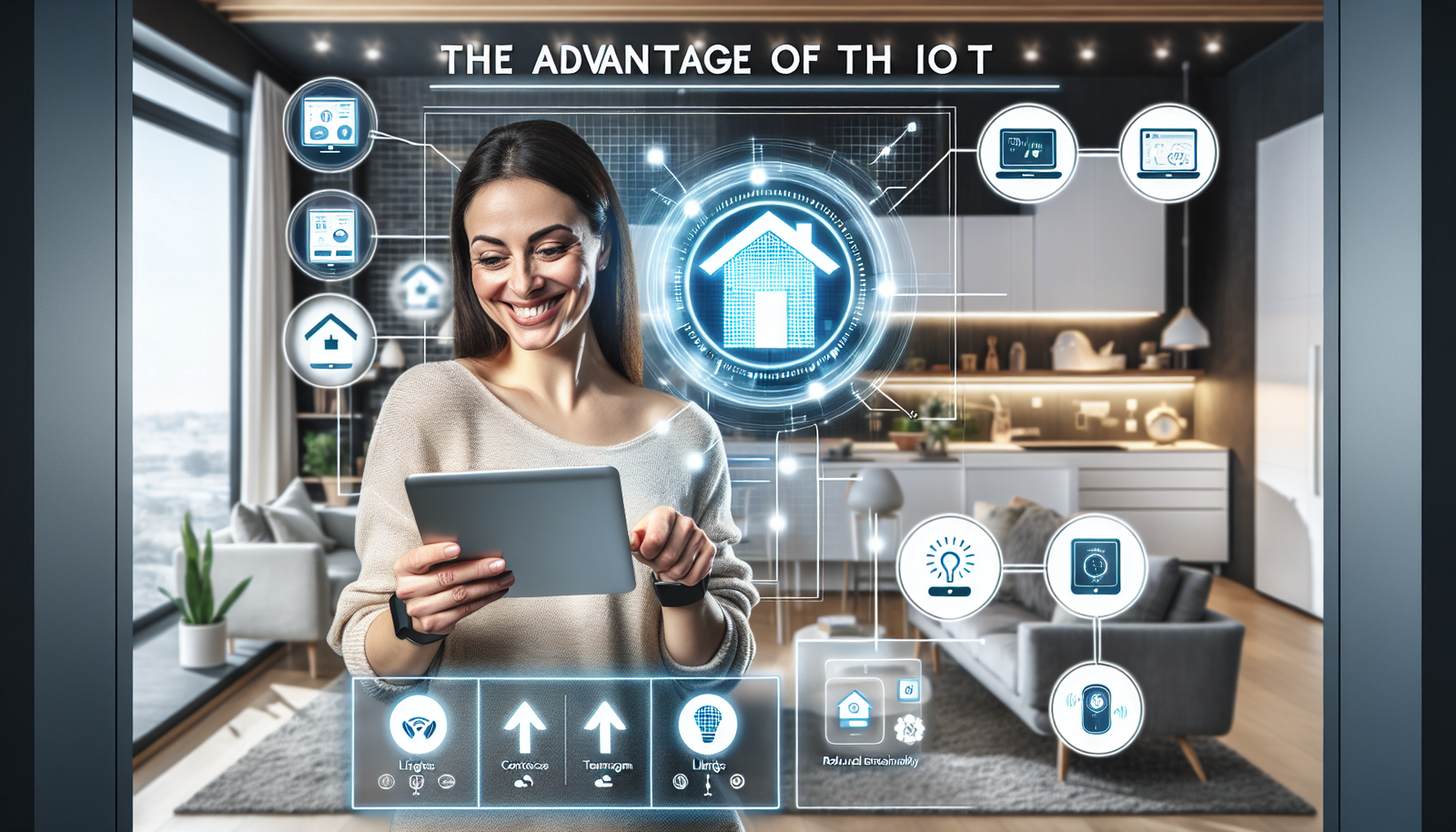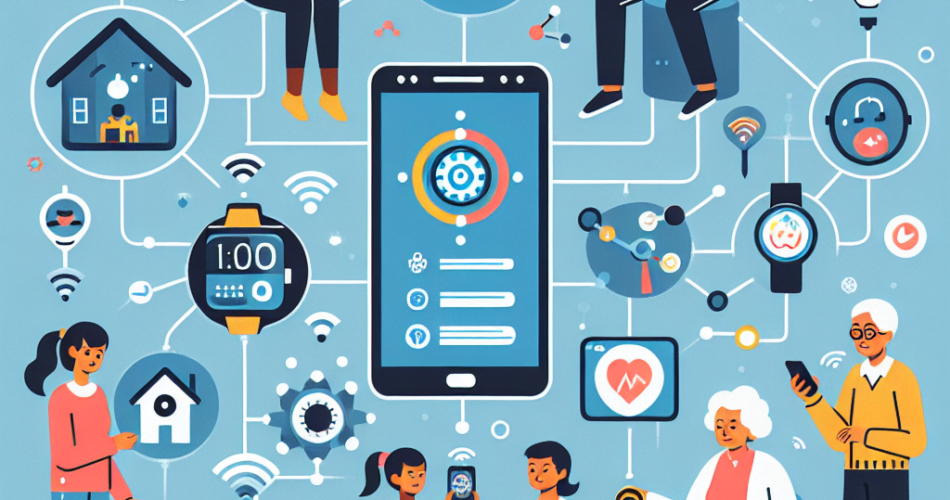Article Index
- How the Internet of Things is revolutionizing global connectivity
- Increasing efficiency with the Internet of Things: practical examples
- Smart monitoring: how the Internet of Things is transforming security and control
- Automation and innovation: how the Internet of Things is driving new business opportunities
- Questions and answers
“Connect to the future with the Internet of Things!”
The Internet of Things (IoT) is a technology that connects physical devices to the internet, allowing the exchange of data and information between them. This interconnection offers a number of advantages and benefits in various sectors such as health, transportation, agriculture, industry and residences. IoT enables Automation of processes, Monitoring in real time, accurate data collection and more efficient decision making. In addition, it promotes resource optimization, cost reduction, increased productivity and improved people's quality of life.
The advantage of the Internet of Things is the ability to connect devices and collect data in real time, allowing greater efficiency and automation in various sectors. To learn more about this theme, READ MORE.
How the Internet of Things is revolutionizing global connectivity

The Internet of Things (IoT) has been one of the largest technological innovations in recent years. It is revolutionizing the way we connect and interact with the world around us. IoT is a network of physical devices, vehicles, appliances and other embedded objects with sensors, software and Connectivity network, which allow the exchange of data and communication between each other.
One of the main advantages of IoT is its ability to connect devices and objects on a global scale. Before IoT, a Connectivity was limited to computers and smartphones. Now, with IoT, we can connect almost anything to the internet, from refrigerators and cars to lamps and thermostats. This means we can control and monitor these devices remotely, making our lives more convenient and efficient.
In addition, IoT is transforming the way companies operate. With IoT, companies can collect real-time data about their products and services, allowing them to make more informed and effective decisions. For example, a logistics company can use sensors in their trucks to monitor location, speed and load conditions in real time. This allows them to optimize their delivery routes, saving time and money.
Another advantage of IoT is its ability to improve people's quality of life. With IoT, we can have smart homes where we can remotely control lighting, heating, security and other devices. This not only makes our lives more convenient, but also can help us save energy and reduce our environmental impact.
IoT is also revolutionizing the health area. With IoT, medical devices can be connected to the internet, allowing doctors to monitor their patients remotely. This is especially useful for patients with chronic conditions such as diabetes or heart disease, which need to be monitored regularly. With IoT, these patients can avoid frequent hospital visits and receive personalized care at home.
However, despite all the advantages of IoT, there are also concerns regarding the security and privacy of the data. With so many devices connected to the internet, there is a greater risk of cyber attacks and data theft. In addition, large-scale data collection also raises questions about people's privacy. It is important that companies and governments implement robust security and privacy measures to protect user data.
In conclusion, the Internet of Things is revolutionizing Connectivity global. It is connecting devices and objects on a scale never before seen, making our lives more convenient and efficient. In addition, IoT is transforming the way companies operate and improving people's quality of life. However, it is important to address concerns about data security and privacy to ensure that IoT is used responsibly and safely. IoT has the potential to change the world, and it's up to us to make the most of this innovative technology.
Increasing efficiency with the Internet of Things: practical examples
The Internet of Things (IoT) has become increasingly present in our lives, bringing with it a number of advantages and benefits. One of the main advantages of IoT is the ability to increase Efficiency in several sectors, making processes faster, accurate and economic. In this section, we will explore some practical examples of how IoT has been used to improve the Efficiency in different areas.
One of the sectors that has benefited widely from IoT is that of agriculture. With the use of sensors and connected devices, farmers can accurately and in real time monitor soil conditions, humidity, temperature and other factors affecting plant growth. This allows them to make more informed decisions about irrigation, the application of fertilizers and agricultural defensives, resulting in a more efficient use of resources and an increase in productivity.
Another practical example of how IoT has been used to increase Efficiency is in the logistics area. With the use of sensors and devices connected in trucks, containers and warehouses, it is possible to track in real time the location and status of the products in transit. This allows companies to optimize delivery routes, avoiding delays and reducing transportation costs. In addition, IoT can also be used to monitor storage conditions such as temperature and humidity, ensuring product quality throughout the logistic process.
In the area of health, IoT has also played a key role in improving health Efficiency. With the use of connected devices, doctors can remotely monitor the vital signs of patients such as heartbeat, blood pressure and glucose levels. This allows more accurate and continuous monitoring, avoiding unnecessary hospitalizations and reducing treatment costs. In addition, IoT can also be used to monitor drug intake, ensuring that patients are properly following the prescribed treatment.
Another practical example of how IoT has been used to increase Efficiency is in the energy area. With the use of connected devices, it is possible to monitor energy consumption in real time, identifying usage patterns and identifying economic opportunities. In addition, IoT can also be used for intelligently control the use energy in homes and commercial buildings, automatically adjusting lighting, heating and cooling according to occupation and climatic conditions. This results in a significant reduction in energy consumption and associated costs.
In short, the Internet of Things has been shown a powerful tool to increase Efficiency in several sectors. Through the use of connected sensors and devices, it is possible to accurately and in real time monitor and control a number of variables, resulting in faster, accurate and economic processes. The practical examples presented in this section are just a few of the many successful cases of IoT, and the trend is that its use continues to expand, bringing more and more benefits to companies and consumers.
Smart monitoring: how the Internet of Things is transforming security and control
The Internet of Things (IoT) has become increasingly present in our lives, transforming the way we interact with the world around us. One of the areas where IoT has shown great potential is in Monitoring smart, bringing significant benefits to security and control.
With IoT, connected devices can collect and transmit data in real time, allowing a Monitoring more efficient and accurate. This is especially relevant when it comes to security, where the ability to monitor and respond to real-time events can make all the difference.
A practical example of how IoT is transforming security is the Monitoring of residences. With the installation of sensors and cameras connected to the internet, owners can monitor their homes remotely, receiving alerts on their smartphones in case of suspicious activities. In addition, these devices can be integrated into security systems such as alarms and smart latches, allowing an immediate response in case of invasion.
Another area where IoT is revolutionizing Monitoring intelligent is in the control of industrial processes. With the ability to collect real-time data from connected sensors and devices, companies can more efficiently monitor and control their production processes. This allows early detection of problems and the implementation of corrective measures before they become major failures.
In addition, IoT is also bringing benefits to the Monitoring health. With wearable devices connected to the internet, patients can monitor their vital signs and share this information with their doctors in real time. This allows more accurate and personalized follow-up, as well as enabling early detection of health problems.
However, it is important to note that IoT implementation in Monitoring Smart also brings challenges. Data security is a fundamental concern, since the amount of information transmitted and stored is significant. It is essential to ensure that the information collected is protected from unauthorized access and that the privacy of users is preserved.
In addition, interoperability between devices is also a challenge to be overcome. With the diversity of manufacturers and communication protocols, it is necessary to ensure that devices can communicate with each other efficiently and smoothly.
Despite these challenges, IoT continues to advance and transform the way we monitor and control the world around us. With the ability to collect and transmit data in real time, IoT is bringing significant benefits to security and control, enabling faster and more efficient response to events and problems.
In short, IoT is revolutionizing Monitoring smart, bringing benefits to security and control in various areas such as homes, industrial processes and health. However, it is important to address the challenges related to data security and interoperability to ensure the success of IoT implementation. With the continuous advancement of technology, we can expect IoT to continue to transform and improve our lives.
Automation and innovation: how the Internet of Things is driving new business opportunities
The Internet of Things (IoT) has become increasingly present in our lives, bringing with it a number of advantages and business opportunities. Through Automation and Innovation, the IoT is revolutionizing how we interact with the world around us.
One of the main advantages of IoT is the ability to automate tasks and processes, making them more efficient and economic. With the connection of devices and sensors to the internet, it is possible to remotely monitor and control a multitude of activities, from temperature control in a house to stock management in a company.
That's right. Automation brings benefits to both the final consumer and the companies. In the case of the consumer, for example, IoT allows him to control his home remotely, adjusting the temperature, triggering appliances and even monitoring security through internet-connected surveillance cameras.
For companies, IoT offers the opportunity to optimize processes and reduce costs. For example, a plant can use sensors to monitor the performance of its machines, identifying possible failures before they occur. This allows the company to take preventive measures, avoiding stops in production and reducing costs with corrective maintenance.
Beyond Automation, IoT also drives Innovation, opening up space for the development of new products and services. With the internet device connection, you can collect a huge amount of data in real time. This data can be analyzed and used to identify consumer standards, trends and needs.
This data analysis allows companies to offer customized products and services according to the preferences and needs of each client. For example, a retail company can use data collected through sensors in their stores to identify which products are most popular in certain regions, thus adjusting their stock and product offering.
In addition, IoT is also driving the creation of new business models. With the connection of internet devices, it is possible to offer subscription-based services where the client pays a monthly fee to have access to certain products or features. This business model has been very profitable since it allows companies to have a recurring recipe and loyalty their customers.
However, it is important to note that IoT also brings with it challenges and concerns. Data security, for example, is a matter that needs to be taken seriously. With the connection of internet devices, it is necessary to ensure that the information collected is protected from possible cyber attacks.
In addition, user privacy is also a concern. With large-scale data collection, it is important that companies are transparent and respect the privacy of their customers, ensuring that the information collected is used ethically and responsibly.
In conclusion, the Internet of Things is driving new business opportunities through Automation and Innovation. By connecting devices to the internet, you can automate tasks and processes, making them more efficient and cost-effective. In addition, IoT also drives Innovation, enabling the development of new customized products and services. However, it is important that companies are attentive to the challenges and concerns related to data security and privacy.
Questions and answers
1. What are the Internet advantages Things?
The Internet of Things offers several advantages, such as Automation of tasks, higher Efficiency operational, Monitoring in real time, data-based decision making, better quality of life, energy saving and resources, among others.
2. How the Internet of Things can improve Efficiency operational?
The Internet of Things allows connection and communication between devices, machines and systems, which enables real-time data collection and analysis. This allows problem identification and solution implementation faster and more efficiently, resulting in an improvement in Efficiency operational.
3. What are the benefits of the Internet of Things for quality of life?
The Internet of Things can improve people's quality of life in various ways. For example, connected devices can monitor health and provide alerts in case of emergency. In addition, Automation Residential allows remote control of devices and systems, providing greater comfort and convenience.
4. How does the Internet of Things contribute to energy savings and resources?
The Internet of Things allows Monitoring and intelligent control of devices and systems, which helps optimize energy consumption and resources. For example, sensors can automatically adjust lighting and heating in environments based on the presence of people, resulting in energy savings. In addition, intelligent resource management such as water and electricity can be performed based on real-time data, reducing waste. The Internet of Things (IoT) offers several significant advantages. One is the ability to connect devices and systems, allowing you to exchange information in real time. This makes it possible to Automation of processes, increasing Efficiency and reducing costs. In addition, IoT allows the collection and analysis of large volumes of data, which can lead to valuable insights and improvements in products and services. A Connectivity provided by IoT can also improve people's quality of life, providing intelligent solutions for areas such as health, safety and mobility. In short, the Internet of Things offers a number of benefits that can drive Innovation and transform various sectors of society.







